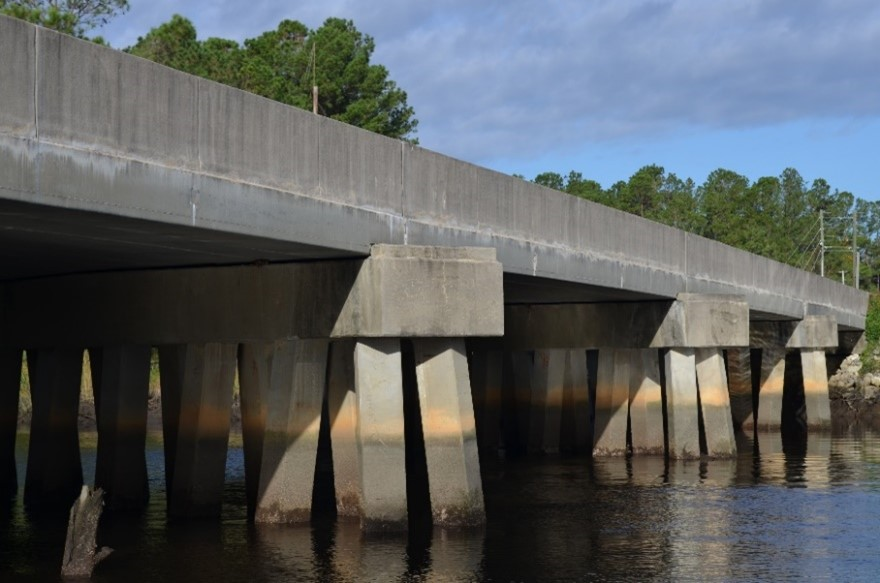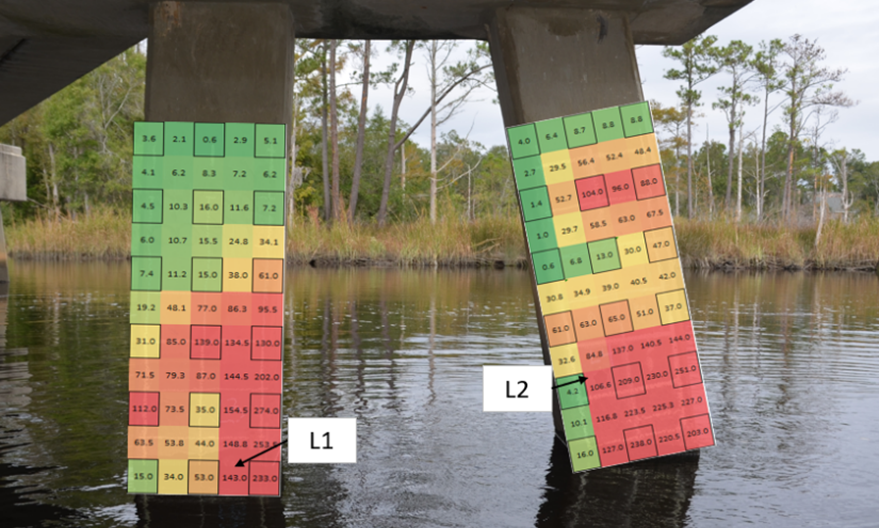This study was undertaken to determine whether the specified cover requirements, fly ash and silica fume addition rates, and corrosion inhibitor dosage rates described in the North Carolina Department of Transportation's Structures Design Manual are consistently and sufficiently achieving their objective of delaying the onset of corrosion in coastal concrete bridges. Additionally, this study was tasked with evaluating the current method of delineating the corrosive and highly corrosive zones. In order to evaluate the effectiveness of the current policy for corrosive sites, the research team used literature review, field evaluation, laboratory testing, and life-cycle modeling methods.
The most significant active corrosion was detected in the tidal zone of bridge piers, although the corrosion rate was significantly reduced at locations outside of the tidal zone. Limited evidence of corrosion was detected or observed on the portions of the bridges that receive only atmospheric contact with chlorides through spray, splashing, and mist. On almost all elements tested, chloride concentration tests indicated a rapid decrease of chloride contamination between the surface and two inches below the surface. The significant contamination of chloride was limited mostly to the portions of the structure that are frequently exposed to brackish waters. Most concrete was found to have diffusion coefficients lower than the typical/target values proposed for 100-year service life by NCDOT.


 (a) Perspective on high tide location, (b) Piers: corrosion rate heat map
(a) Perspective on high tide location, (b) Piers: corrosion rate heat map(c) Piers: Surface resistivity heat map
However, most structures located very close to the ocean were found to have more severe exposure than would be anticipated by those models. In most cases the calcium nitrite corrosion inhibiting admixture concentrations measured from powder samples collected in the field met or exceeded the specified NCDOT minimum addition rate of 3 gal/yd3. This finding confirmed that calcium nitrite is being utilized in the mixtures in approximately the correct dosage rates. However, the dosage rate did not have the expected effect of raising the corrosion initiation threshold of chloride concentration to above 9 lb/yd3.
The findings of this research project suggest that the current corrosion policy is effective delaying the onset of corrosion in concrete components in most cases. It is effective at providing protection to concrete elements that are receiving chloride loading from splashing, spray, or atmospheric deposition. It is also effective at providing protection to bridges in locations where the concentration of chlorides in the brackish water is low. However, many bridges constructed under the current corrosion policy are not on track to have total maintenance-free service lives in excess of 75 or 100 years. Bridges that meet the current specified requirements of the corrosion policy to include silica fume, proper concrete cover, and corrosion inhibiting admixture, may have maintenance-free service lives of less than 50 years if they are located very close to the ocean.
